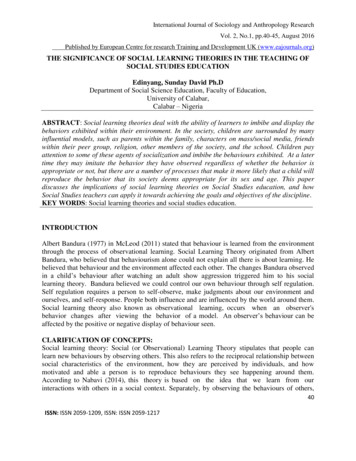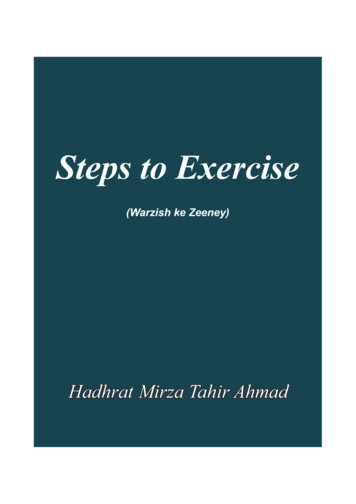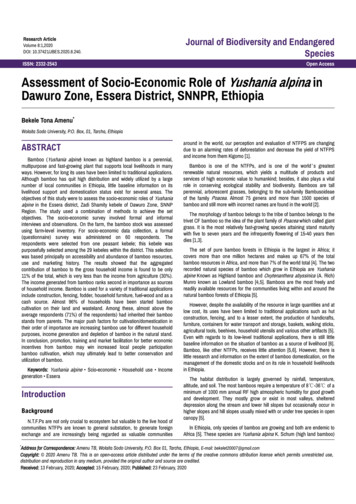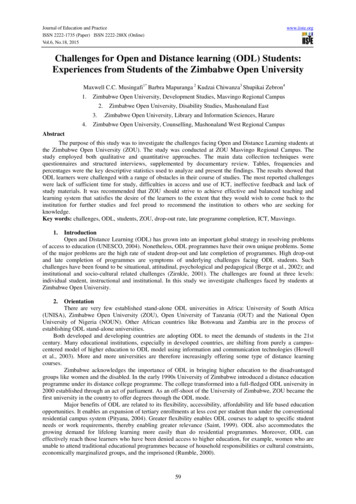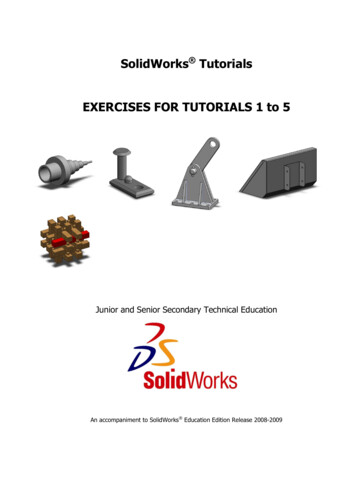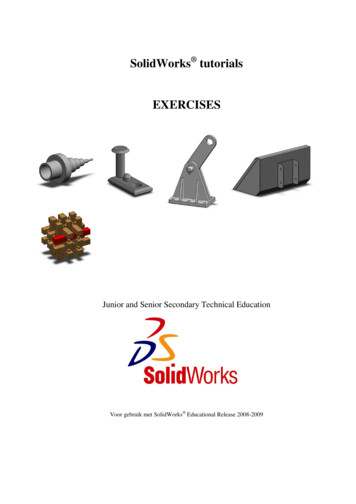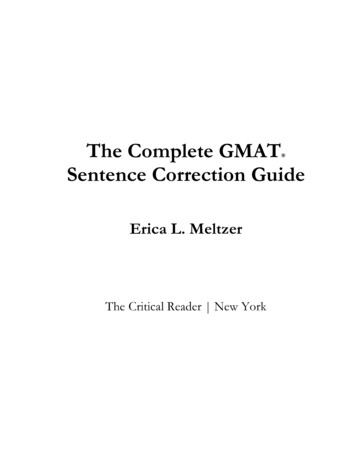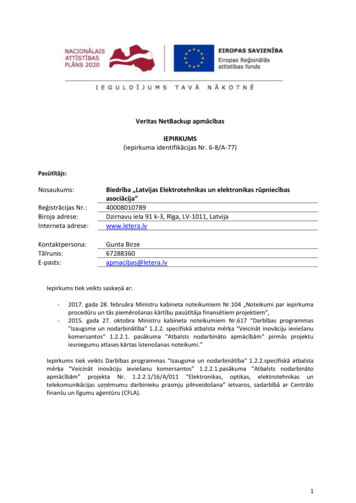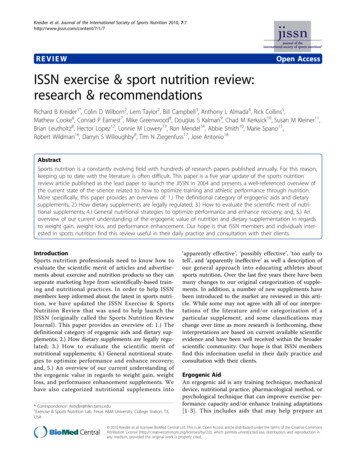
Transcription
Kreider et al. Journal of the International Society of Sports Nutrition 2010, 7:7http://www.jissn.com/content/7/1/7REVIEWOpen AccessISSN exercise & sport nutrition review:research & recommendationsRichard B Kreider1*, Colin D Wilborn2, Lem Taylor2, Bill Campbell3, Anthony L Almada4, Rick Collins5,Mathew Cooke6, Conrad P Earnest7, Mike Greenwood8, Douglas S Kalman9, Chad M Kerksick10, Susan M Kleiner11,Brian Leutholtz8, Hector Lopez12, Lonnie M Lowery13, Ron Mendel14, Abbie Smith10, Marie Spano15,Robert Wildman16, Darryn S Willoughby8, Tim N Ziegenfuss17, Jose Antonio18AbstractSports nutrition is a constantly evolving field with hundreds of research papers published annually. For this reason,keeping up to date with the literature is often difficult. This paper is a five year update of the sports nutritionreview article published as the lead paper to launch the JISSN in 2004 and presents a well-referenced overview ofthe current state of the science related to how to optimize training and athletic performance through nutrition.More specifically, this paper provides an overview of: 1.) The definitional category of ergogenic aids and dietarysupplements; 2.) How dietary supplements are legally regulated; 3.) How to evaluate the scientific merit of nutritional supplements; 4.) General nutritional strategies to optimize performance and enhance recovery; and, 5.) Anoverview of our current understanding of the ergogenic value of nutrition and dietary supplementation in regardsto weight gain, weight loss, and performance enhancement. Our hope is that ISSN members and individuals interested in sports nutrition find this review useful in their daily practice and consultation with their clients.IntroductionSports nutrition professionals need to know how toevaluate the scientific merit of articles and advertisements about exercise and nutrition products so they canseparate marketing hype from scientifically-based training and nutritional practices. In order to help ISSNmembers keep informed about the latest in sports nutrition, we have updated the ISSN Exercise & SportsNutrition Review that was used to help launch theJISSN (originally called the Sports Nutrition ReviewJournal). This paper provides an overview of: 1.) Thedefinitional category of ergogenic aids and dietary supplements; 2.) How dietary supplements are legally regulated; 3.) How to evaluate the scientific merit ofnutritional supplements; 4.) General nutritional strategies to optimize performance and enhance recovery;and, 5.) An overview of our current understanding ofthe ergogenic value in regards to weight gain, weightloss, and performance enhancement supplements. Wehave also categorized nutritional supplements into* Correspondence: rkreider@hlkn.tamu.edu1Exercise & Sports Nutrition Lab, Texas A&M University, College Station, TX,USA‘apparently effective’, ‘possibly effective’, ‘too early totell’, and ‘apparently ineffective’ as well a description ofour general approach into educating athletes aboutsports nutrition. Over the last five years there have beenmany changes to our original categorization of supplements. In addition, a number of new supplements havebeen introduced to the market are reviewed in this article. While some may not agree with all of our interpretations of the literature and/or categorization of aparticular supplement, and some classifications maychange over time as more research is forthcoming, theseinterpretations are based on current available scientificevidence and have been well received within the broaderscientific community. Our hope is that ISSN membersfind this information useful in their daily practice andconsultation with their clients.Ergogenic AidAn ergogenic aid is any training technique, mechanicaldevice, nutritional practice, pharmacological method, orpsychological technique that can improve exercise performance capacity and/or enhance training adaptations[1-3]. This includes aids that may help prepare an 2010 Kreider et al; licensee BioMed Central Ltd. This is an Open Access article distributed under the terms of the Creative CommonsAttribution License (http://creativecommons.org/licenses/by/2.0), which permits unrestricted use, distribution, and reproduction inany medium, provided the original work is properly cited.
Kreider et al. Journal of the International Society of Sports Nutrition 2010, 7:7http://www.jissn.com/content/7/1/7individual to exercise, improve the efficiency of exercise,and/or enhance recovery from exercise. Ergogenic aidsmay also allow an individual to tolerate heavy trainingto a greater degree by helping them recover faster orhelp them stay injury-free and/or healthy during intensetraining. Although this definition seems rather straightforward, there is considerable debate regarding the ergogenic value of various nutritional supplements. Somesports nutrition specialists only consider a supplementergogenic if studies show that the supplement significantly enhances exercise performance (e.g., helps yourun faster, lift more weight, and/or perform more workduring a given exercise task). On the other hand, somefeel that if a supplement helps prepare an athlete to perform or enhances recovery from exercise, it has thepotential to improve training adaptations and thereforeshould be considered ergogenic. In the view of theISSN, one should take a broader view about the ergogenic value of supplements. While we are interested indetermining the performance enhancement effects of asupplement on a single bout of exercise, we also realizethat one of the goals of training is to help people tolerate a greater degree of training. Individuals who betteradapt to high levels of training usually experiencegreater gains from training over time which can lead toimproved performance. Consequently, employing nutritional practices that help prepare individuals to performand/or enhance recovery from exercise should also beviewed as ergogenic.Definition and Regulation of Dietary SupplementsAs described in Exercise and Sports Nutrition: Principles, Promises, Science & Recommendations [3]; according to the Food and Drug Administration (FDA), dietarysupplements were regulated in the same manner as foodprior to 1994 [4]. Consequently, the FDA monitored themanufacturing processes, quality, and labeling of dietarysupplements. However, many people felt that the FDAwas too restrictive in regulating dietary supplements. Asa result, Congress passed the Dietary Supplement Healthand Education Act (DSHEA) in 1994 which placed dietary supplements in a special category of “foods”. InOctober 1994, President Clinton signed DSHEA intolaw. The law defined a “dietary supplement” as a product taken by mouth that contains a “dietary ingredient”intended to supplement the diet. “Dietary ingredients”may include vitamins, minerals, herbs or other botanicals, amino acids, and substances (e.g., enzymes, organtissues, glandular, and metabolites). Dietary supplementsmay also be extracts or concentrates from plants orfoods. Dietary supplements are typically sold in the formof tablets, capsules, soft gels, liquids, powders, and bars.Products sold as dietary supplements must be clearlylabeled as a dietary supplement.Page 2 of 43According to DSHEA, dietary supplements are notdrugs. Dietary supplement ingredients that were lawfullysold prior to 1994, have been “grandfathered” into theAct, meaning that a manufacturer is not required tosubmit to FDA the evidence it relies upon to substantiate safety or effectiveness before or after it marketsthese ingredients. The rationale for this exclusion isbased on a long history of safe use; hence there is noneed to require additional safety data. However, DSHEAgrants FDA greater control over supplements containingnew dietary ingredients. A new dietary ingredient isdeemed adulterated and subject to FDA enforcementsanctions unless it meets one of two exemption criteria:either 1.) the supplement in question contains “onlydietary ingredients which have been present in the foodsupply as an article used for food in a form in which thefood has not been chemically altered"; or 2.) there is a“history of use or other evidence of safety” provided bythe manufacturer or distributor to FDA at least 75 daysbefore introducing the product into interstate commerce. The second criterion, applicable only to newdietary ingredients that have not been present in thefood supply, requires manufacturers and distributors ofa new dietary ingredient or a product containing a newdietary ingredient to submit pre-market notification tothe FDA. This notification, which must be submitted atleast 75 days before the product is introduced into interstate commerce, must contain information that providesa history of use or other evidence of safety establishingthat the dietary ingredient, when used under the conditions recommended or suggested in the labeling of thedietary supplement will “reasonably be expected to besafe.” This may include conducting in vitro toxicologytesting, long-term toxicity studies using varying doses inanimals to see if there are any toxic effects, providingmanufacturing and quality assurance data showing purity, and provision of clinical studies conducted inhumans showing safety. The FTC also requires that anyrepresentations or claims made about the supplementbe substantiated by adequate evidence to show that theyare not false or misleading, a policy which is also sharedby the FDA. This involves, for example, providing atleast two clinical trials showing efficacy of the actualproduct, within a population of subjects relevant to thetarget market, supporting the structure/function claimsthat are made. Structure/function claims may includeseveral categories. They may describe the role of a nutrient or dietary ingredient intended to affect normalstructure or function in humans, they may characterizethe means by which a nutrient or dietary ingredient actsto maintain such structure or function, they maydescribe general well-being from consumption of anutrient or dietary ingredient or they may describe abenefit related to a nutrient deficiency disease, as long
Kreider et al. Journal of the International Society of Sports Nutrition 2010, 7:7http://www.jissn.com/content/7/1/7as the statement also tells how widespread such a disease is in the United States. Manufacturers of dietarysupplements that make structure/function claims onlabels or in labeling must submit a notification to FDAno later than 30 days after marketing the dietary supplement that includes the text of the structure/functionclaim. DSHEA also requires supplement manufacturersto include on any label displaying structure/functionclaims the disclaimer “This statement has not been evaluated by the FDA. This product is not intended to diagnose, treat, cure, or prevent any disease”. Opponents ofdietary supplements often cite this statement as evidence that the FDA did not review or approve the dietary supplement when in fact most dietary ingredientshave been grandfathered in due to a long history of safesale; whereas those products containing a new dietaryingredient which is not present in the food supply as anarticle used for food in a form in which the food hasnot been chemically altered are subject to pre-marketnotification to FDA regarding history of use or otherevidence of safety. Unfortunately, a large number of newdietary ingredients requiring pre-market notificationhave been introduced into dietary supplements sinceOctober 1994 without the requisite notification.According to the 1994 Nutrition Labeling and Education Act (NLEA), the FDA has the ability to review andapprove health claims for dietary ingredients and foods.However, since the law was passed it has only approveda few claims. The delay in reviewing health claims ofdietary supplements resulted in a lawsuit filed by Pearson & Shaw et al v. Shalala et al in 1993. After yearsof litigation, the U.S. Court of Appeals for the Districtof Columbia Circuit ruled in 1999 that qualified healthclaims may now be made about dietary supplementswith approval by FDA as long as the statements aretruthful and based on science. Supplement or food companies wishing to make health claims about supplementscan submit research evidence to the FDA for approvalof a health claim. Additionally, companies must alsosubmit an Investigational New Drug (IND) applicationto FDA if a research study on a nutrient or multipledietary ingredient composition is designed to treat anillness and/or medical affliction and/or the companyhopes to one day obtain approval for making a qualifiedhealth claim as a prescription or orphan drug if the outcome of the study supports the claim. Studies investigating structure/function claims, however, do not need tobe submitted to the FDA as an IND. The 1997 Foodand Drug Administration Modernization Act (FDAMA)provided for health claims based on an authoritativestatement of a scientific body of the U.S. Governmentor the National Academy of Sciences; such claims maybe used after submission of a health claim notificationto FDA; and the 2003 FDA Consumer HealthPage 3 of 43Information for Better Nutrition Initiative provided forqualified health claims where the quality and strength ofthe scientific evidence falls below that required for FDAto issue an authorizing regulation. Such health claimsmust be qualified to assure accuracy and non-misleadingpresentation to consumers. More recently, the U.S. Senate passed legislation (Senate Bill 1082) that establishedthe Reagan-Udall Foundation for the FDA. The purposeof this non-profit foundation is to lead collaborationsamong the FDA, academic research institutions, andindustry to enhance research in evaluating the safetyand efficacy of dietary supplements as well as toimprove the quality and management of these products.For many years, manufacturers and distributors ofdietary supplements were not required to record, investigate or forward to FDA any reports they receive oninjuries or illnesses that may be related to the use oftheir products. However, companies are now requiredby the Dietary and Supplement and NonprescriptionDrug Consumer Act (Public Law 109-462 109th Congress Dec. 22, 2006) to record all adverse event complaints about their products and make them available tothe FDA pursuant to an inspection. Reports of “serious”adverse events (i.e., adverse events which results indeath, a life-threatening experience, inpatient hospitalization, a persistent or significant disability or incapacity,or a congenital anomaly or birth defect; or requires,based on a reasonable medical judgment, a medical orsurgical intervention to prevent an outcome describedabove) must be reported to FDA within 15 businessdays. While these reports are unsubstantiated; can beinfluenced by media attention to a particular supplement; and do not necessarily show a cause and effect:they can be used by the company and FDA to monitortrends and “signals” that may suggest a problem. Once adietary supplement product is marketed, the FDA hasthe responsibility for showing that the dietary supplement is unsafe before it can take action to restrict theproduct’s use or removal from the marketplace. TheFTC maintains responsibility to make sure manufacturers are truthful and not misleading regarding claimsthey make about dietary supplements. The FDA has thepower to remove supplements from the market if it hassufficient scientific evidence to show the supplement isunsafe. Once they do, they must have sufficient evidenceto meet review by the Office of General Accounting(OGA) and/or legal challenges. In the past, the FDA hasacted to remove dietary supplements from the marketonly to be concluded by the OGA and/or federal courtsto have overstepped their authority. Additionally, theFTC has the power to act against companies who makefalse and/or misleading marketing claims about a specific product. This includes acting against companies ifthe ingredients found in the supplement do not match
Kreider et al. Journal of the International Society of Sports Nutrition 2010, 7:7http://www.jissn.com/content/7/1/7label claims or in the event undeclared, drug ingredientsare present (e.g., analogs of weight loss drugs, diureticdrugs). While this does not ensure the safety of dietarysupplements, it does provide a means for governmentaloversight of the dietary supplement industry if adequateresources are provided to enforce DSHEA. Since theinception of DSHEA, the FDA has required a number ofsupplement companies to submit evidence showingsafety of their products and acted to remove a numberof products sold as dietary supplements from sale in theUnited States due to safety concerns. Additionally, theFTC has acted against a number of supplement companies for misleading advertisements and/or structure andfunction claims.As demonstrated, while some argue that the dietarysupplement industry is “unregulated” and/or may havesuggestions for additional regulation, manufacturers ofdietary supplements must adhere to a number of federalregulations before a product can go to market. Further,they must have evidence that the ingredients sold intheir supplements are generally safe if requested to doso by the FDA. For this reason, over the last 20 years, anumber of quality supplement companies haveemployed research and development directors who helpeducate the public about nutrition and exercise, provideinput on product development, conduct preliminaryresearch on products, and/or assist in coordinatingresearch trials conducted by independent research teams(e.g., university based researchers or clinical researchsites). They also consult with marketing and legal teamswith the responsibility to ensure structure and functionclaims do not misrepresent results of research findings.This has increased job opportunities for sports nutritionspecialists as well as enhanced external funding opportunities for research groups interested in exercise andnutrition research.While it is true that a number of companies falselyattribute research on different dietary ingredients ordietary supplements to their own, suppress negativefindings, and/or exaggerate results from research studies;the trend in the nutrition industry has been to developscientifically sound supplements. This trend towardgreater research support is the result of: 1.) Attempts tohonestly and accurately inform the public about results;2.) Efforts to have data to support safety and efficacy onproducts for FDA and the FTC; and/or, 3.) To providescientific evidence to support advertising claims andincrease sales. This trend is due in part to greater scrutiny from the FDA and FTC, but also in response to anincreasingly competitive marketplace where establishedsafety and efficacy attracts more consumer loyalty andhelps ensure a longer lifespan for the product in commerce. In our experience, companies who adhere tothese ethical standards prosper while those who do notPage 4 of 43struggle to comply with FDA and FTC guidelines andrapidly lose consumer confidence, signaling an earlydemise for the product.Product Development and Quality AssuranceOne of the most common questions raised by athletes,parents, and professionals regarding dietary supplementsrelates to how they are manufactured and consumerawareness of supplement quality. In a number of cases,reputable companies who develop dietary supplementshave research teams who scour the medical and scientific literature looking for potentially effective nutrients.These research teams often attend scientific meetingsand review the latest patents, research abstracts presented at scientific meetings, and research publications.They may also consult with leading researchers to discuss ideas about dietary supplements that can be commercialized. Leading companies invest in basic researchon nutrients before developing their supplement formulations. Others wait until research has been presented inpatents, research abstracts, or publications before developing nutritional formulations featuring the nutrient.Once a new nutrient or formulation has been identified,the next step is to contact raw ingredient suppliers tosee if the nutrient can be obtained in a highly puresource and/or if it’s affordable. Sometimes, companiesdevelop and patent new processing and purification processes because the nutrient has not yet been extractedin a pure form or is not available in large quantities.Reputable raw material manufacturers conduct extensivetests to examine purity of their raw ingredients. If thecompany is working on a new ingredient, they oftenconduct toxicity studies on the new nutrient once a purified source has been identified. They would then compile a safety dossier and communicate it to the FDA asa New Dietary Ingredient submission, with the hopes ofit being allowed for lawful sale.When a powdered formulation is designed, the list ofingredients and raw materials are typically sent to a flavoring house and packaging company to identify thebest way to flavor and package the supplement. In thenutrition industry, there are several main flavoringhouses and packaging companies who make a largenumber of dietary supplements for dietary supplementcompanies. Most reputable dietary supplement manufacturers submit their production facilities to inspectionfrom the FDA and adhere to good manufacturing practices (GMP’s), which represent industry standards forgood manufacturing of dietary supplements. Some companies also submit their products for independent testing by third-party companies to certify that theirproducts meet label claims. For example, NSF’s certification service includes product testing, GMP inspections,ongoing monitoring and use of the NSF Mark indicating
Kreider et al. Journal of the International Society of Sports Nutrition 2010, 7:7http://www.jissn.com/content/7/1/7products comply with inspection standards, and screening for contaminants. More recently, companies havesubjected their products for testing by third party companies to inspect for banned or unwanted substances.These types of tests help ensure that each batch of thedietary supplement does not contained substancesbanned by the International Olympic Committee orother athletic governing bodies (e.g., NFL). While thirdparty testing does not guarantee that a supplement isvoid of banned substances, the likelihood is much less(e.g., Banned Substances Control Group, InformedChoice, etc). Moreover, consumers can request copies ofresults of these tests. In our experience, companies whoare not willing to provide copies of test results are notworth purchasing.Evaluation of Nutritional Ergogenic AidsThe ISSN recommends going through a process of evaluating the validity and scientific merit of claims madewhen assessing the ergogenic value of a dietary supplement/technique [3]. This can be accomplished by examining the theoretical rationale behind the supplement/technique and determining whether there is any wellcontrolled data showing the supplement/techniqueworks. Supplements based on sound scientific rationalewith direct, supportive research showing effectivenessmay be worth trying and/or recommending. However,those based on unsound scientific results and/or little tono data supporting the ergogenic value of the actualsupplement/technique may not be worthwhile. Thesports nutrition specialist should be a resource to helptheir clients interpret the scientific and medical researchthat may impact their welfare and/or help them trainmore wisely and effectively. The following are recommended questions to ask when evaluating the potentialergogenic value of a supplement.Does The Theory Make Sense?Most supplements that have been marketed to improvehealth and/or exercise performance are based on theoretical applications derived from basic and/or clinicalresearch studies. Based on these preliminary studies, atraining device or supplement is often marketed to people proclaiming the benefits observed in these basicresearch studies. Although the theory may appear relevant, critical analysis of this process often reveals flawsin scientific logic and/or that the claims made don’tquite match up with the literature cited. By evaluatingthe literature on your own you can discern whether asupplement has been based on sound scientific evidenceor not. To do so, it is suggested you read reviews aboutthe training method, nutrient, and/or supplement fromresearchers who have been intimately involved in thisline of research and/or consult reliable references aboutPage 5 of 43nutritional and herbal supplements, such as the JISSN[3,5]. We also suggest doing a search on the nutrient/supplement on the National Library of Medicine’s PubMed Online http://www.ncbi.nlm.nih.gov. A quick lookat these references will often help determine if the theory is plausible or not. In our experience, proponents ofergogenic aids often overstate claims made about training devices and/or dietary supplements while opponentsof dietary supplements and ergogenic aids are eitherunaware and/or ignorant of research supporting theiruse. The sports nutrition specialist has the responsibilityto know the literature and/or search available databasesto evaluate whether there is merit or not to a proposedergogenic aid.Is There Any Scientific Evidence Supporting TheErgogenic Value?The next question to ask is whether there is any wellcontrolled data showing effectiveness of the proposedergogenic aid works as claimed in athletes or peopleinvolved in training. The first place to look is the list ofreferences cited in marketing material supporting theirclaims. We look to see if the abstracts or articles citedare general references or specific studies that have evaluated the efficacy of the nutrient/supplement. We thencritically evaluate the abstracts and articles by asking aseries of questions. Are the studies basic research done in animals/clinical populations or have the studies been conducted on athletes/trained subjects? Studies reporting improved performance in rats or persons withtype 2 diabetes may be insightful but research conducted on non-diabetic athletes is much more practical and relevant. Were the studies well controlled? For ergogenic aidresearch, the study should be a placebo controlled,double-blind, and randomized clinical trial if possible. This means that neither the researcher’s nor thesubject’s were aware which group received the supplement or the placebo during the study and thatthe subjects were randomly assigned into the placebo or supplement group. An additional element ofrigor is called a cross-over design, where each subject, at different times (separated by an intervalknown as a “washout period”), is exposed to each ofthe treatments. While utilization of a cross-overdesign is not always feasible, it removes the elementof variability between subjects and increases thestrength of the findings. At times, supplement claimshave been based on poorly designed studies (i.e.,small groups of subjects, no control group, use ofunreliable tests, etc) and/or testimonials which makeinterpretation much more difficult. Well-controlled
Kreider et al. Journal of the International Society of Sports Nutrition 2010, 7:7http://www.jissn.com/content/7/1/7clinical trials provide stronger evidence as to thepotential ergogenic value. Do the studies report statistically significant resultsor are claims being made on non-significant meansor trends reported? Appropriate statistical analysis ofresearch results allows for an unbiased interpretationof data. Although studies reporting statistical trendsmay be of interest and lead researchers to conductadditional research, studies reporting statistically significant results are obviously more convincing. Withthis said, a sports nutrition specialist must be carefulnot to commit type II statistical errors (i.e., indicating that no differences were observed when a trueeffect was seen but not detected statistically). Sincemany studies on ergogenic aids (particularly in highlevel athletes) evaluate small numbers of subjects,results may not reach statistical significance eventhough large mean changes were observed. In thesecases, additional research is warranted to furtherexamine the potential ergogenic aid before conclusions can be made. Do the results of the studies cited match the claimsmade about the supplement? It is not unusual formarketing claims to greatly exaggerate the resultsfound in the actual studies. Additionally, it is notuncommon for ostensibly compelling results, thatmay indeed by statistically significant, to be amplifiedwhile other relevant findings of significant consumerinterest are obscured or omitted (e.g. a dietary supplement showing statistically significant increases incirculating testosterone yet changes in body composition or muscular performance were not superior to aplacebo). The only way to determine this is to readthe entire article, and not just the abstract or eventhe article citation, and compare results observed inthe studies to marketing claims. Reputable companiesaccurately and completely report results of studies sothat consumers can make informed decisions aboutwhether to try a product or not. Were results of the study presented at a reputablescientific meeting and/or published in a peerreviewed scientific journal? At times, claims arebased on research that has either never been published or only published in an obscure journal. Thebest research is typically presented at respectedscientific meetings and/or published in reputablepeer-reviewed journals. Two ways to determine ajournal’s reputation is either identifying the publisheror the “impact factor” of the journal. A number of“peer-reviewed” journals are published by companieswith ties to, or are actually owned by, nutritionalproducts companies (even though they may be available on PubMed). Therefore, we recommend lookingup the publisher’s website and see how many otherPage 6 of 43journals they publish. If you see only a few otherjournals this is a suggestion that
REVIEW Open Access ISSN exercise & sport nutrition review: research & recommendations Richard B Kreider1*, Colin D Wilborn2, Lem Taylor2, Bill Campbell3, Anthony L Almada4, Rick Collins5, Mathew Cooke6, Conrad P Earnest7, Mike Greenwood8, Douglas S Kalman9, Chad M Kerksick10, Susan M Kleiner11, B
